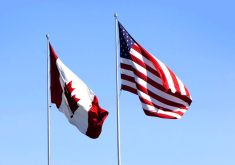CHICAGO, April 2 (Reuters) – Rainy weather and colder-than-normal soil temperatures should delay corn planting in most of the U.S. Midwest for at least the next week, crop and weather experts said on Wednesday.
“It looks like it is going to be pretty wet for the next several days. With the combination of low soil temperatures and heavy rainfall in the near term, it probably could be a week to two weeks of planting delays,” said Josh Senechal, meteorologist with Freese-Notis Weather.
The sluggish start to planting in the United States, the world’s top corn supplier, follows an unusually cold winter and a cool spring. The average air temperature in Chicago for December through March was the coldest on record at 22 degrees Fahrenheit (minus 5 Celsius), the National Weather Service said.
Read Also

Trade tensions boosted confidence in Canadian food system, report shows
U.S. tariff threats have boosted Canadians’ view of the nation’s food system according to the 2025 public trust report from the Canadian Centre for Food Integrity. Trust in Canadian farmers remains high but has been eclipsed by trust in scientists.
Much of the Midwest experienced the most severe winter in 30 years, the Midwest Regional Climate Center has said.
The ground is too cold to plant in much of the Corn Belt. Farmers typically wait until soil temperatures approach 50 degrees Fahrenheit (10 Celsius), warm enough for seeds to germinate.
“Soil temperatures are still in the 30s (F) in northern third of Illinois. They are starting to get up into the low 40s for the rest of the state, but that is way behind what we would we expect them to be for this time of year,” said Jim Angel, the state climatologist of Illinois.
“Farmers are still in a holding pattern right now until we get those soil temperatures warmed up. It’s going to take several weeks of warm weather,” Angel said.
“The season is probably going to run a little bit late,” Monsanto Co Chairman Hugh Grant said in an earnings call.
In parts of Iowa, the biggest U.S. corn producer, soils have thawed near the surface but the ground remains frozen deeper down, said Mark Johnson, a field agronomist with the Iowa State University Extension. A producer trying to plant in such conditions would risk of soil compaction.
“That would make a terrible environment for the roots for the whole year,” Johnson said.
It is far too early to worry about planting delays hurting crop prospects, said Emerson Nafziger, an agronomist at the University of Illinois.
“We did see last year that planting late did not really hurt yields,” Nafziger said. Some Illinois farmers were still planting corn in June of 2013, but the state’s average corn yield reached 178 bushels per acre, the third-highest on record.
Some corn growers like to plant early to bring the crop to pollination, a crucial growth phase, ahead of stressful mid-summer heat. But Johnson said Iowa farmers can safely plant into mid-May without sacrificing yield.
Seeding in the Corn Belt is typically under way by mid-April, with U.S. planting progress reaching at least 2 percent by the middle of the month in each of the last 10 years. For the first week in April, corn planting reached the 2 percent threshold in only five of the last 10 years.
Planting has begun at a slower-than-normal pace in southern states. The Texas corn crop was 28 percent planted by March 30, behind the state’s five-year average of 48 percent.
RAINS TO STALL FIELD WORK
Forecasts for the next week called for widespread rains in the Midwest and the Mississippi River Delta.
“There is a good chance for some planting delays in the Ohio Valley. They have had the heaviest precipitation through the winter months,” Senechal from Freese-Notis Weather said.
“The Upper Midwest also (has) cold soil temperatures. We do think that below-normal temperatures will probably linger for at least the next few weeks in the Upper Midwest,” Senechal said, adding that the highs in that region for the next week will reach the 40s and 50s Fahrenheit.
“The southern Midwest this week will be considerably warmer, south of a front. But in general, above-normal temperatures look to be several weeks away,” Senechal said.














